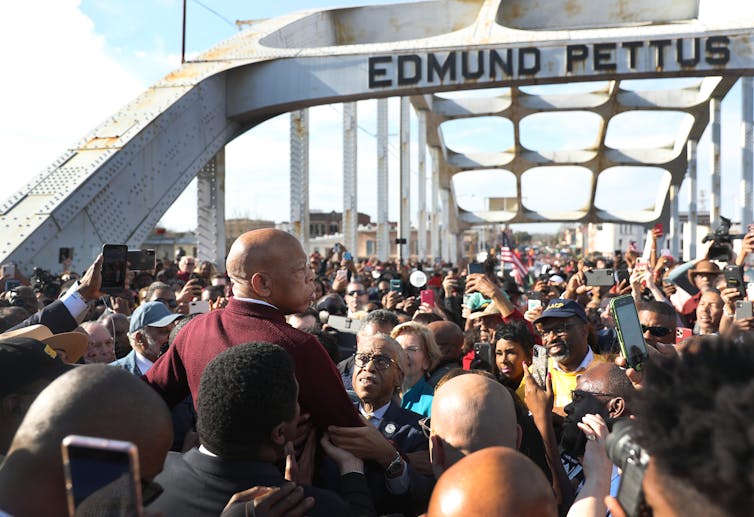On March 7, 1965, Alabama state troopers beat and gassed John Lewis and tons of of marchers on the Edmund Pettus Bridge in Selma, Alabama.
TV reporters and photographers had been there, cameras ready, and the violence captured all through “Bloody Sunday” would go on to stipulate the legacy of Lewis, who died on July 17.
I’m a media historian who has written about television and the civil rights movement. Considered one of many excellent choices of the interval’s media environment, dominated by the comparatively new medium of television info, is how shortly positive events might roil the conscience of the nation.
Confrontations between police and protesters occurred ceaselessly all through the Sixties. Nonetheless a particular set of circumstances ensured that the photographs coming out of Selma galvanized politicians and residents with excellent velocity and depth.
A chief-time event
Most Individuals didn’t see the footage on the 6:30 nightly info. Instead, they seen it later Sunday evening time, which, like proper this second, drew crucial audiences of the week. That evening, ABC was premiering the first TV airing of “Judgment at Nuremberg.” An estimated 48 million people tuned in to look at the Academy Award-winning film, which dealt with the moral culpability of people who had participated inside the Holocaust.
Info purposes on no account obtained these types of rankings. Nonetheless shortly after the movie started, ABC’s info division decided to interrupt the movie with a selected report from Selma.
Viewers may have been peripherally acutely aware of the marches that had been occurring inside the small metropolis 50 miles from Alabama’s capital, Montgomery. Martin Luther King Jr. had kicked off a voting rights advertising and marketing marketing campaign there in January, and the media had been recurrently reporting on the standoffs between Blacks who wanted to register to vote and Selma’s racist, unstable sheriff, Jim Clark.
Two years earlier, footage and pictures of Birmingham Commissioner of Public Safety Bull Connor loosing police canines and high-powered fireside hoses on nonviolent marchers so alarmed the Kennedy administration that the president felt compelled to lastly put forth a sturdy civil rights bill to dismantle Jim Crow segregation inside the South.
Nonetheless until Bloody Sunday, nothing had emerged out of Selma that gripped the nation’s consideration. Even the Birmingham photos didn’t have pretty the speedy impression of those from Selma.
That’s largely because of the actual report interrupted a prime-time broadcast. Nonetheless there was moreover the reality that the footage from Selma thematically complemented “Judgment at Nuremberg.”
Throughout the days after the data film aired, a dozen legislators spoke on the bottom of Congress linking Alabama Gov. George Wallace to Hitler and its state troopers to Nazi storm troopers. Atypical residents made the an identical connections.
“I’ve merely witnessed on television the model new sequel to Adolf Hitler’s brown shirts,” one anguished youthful Alabamian from Auburn wrote to The Birmingham Info. “They’d been George Wallace’s blue shirts. The scene in Alabama appeared like scenes on earlier newsreels of Germany inside the Thirties.”
Throughout the ensuing days, tons of of Individuals jumped into planes, buses and automobiles to get to Selma and stand with the brutalized marchers. The landmark Voting Rights Act handed with excellent velocitymerely 5 months after Bloody Sunday.
The spotlight lastly shines on Lewis
John Lewis, chairman of the Pupil Nonviolent Coordinating Committee, was on the top of the highway of 600 protesters. Their plan was to march 50 miles, from Selma to Montgomery, to protest the present police killing of activist Jimmie Lee Jackson and to press Gov. Wallace for Black voting rights. Subsequent to him, representing King’s group, the Southern Christian Administration Conference, was Hosea Williams. King was once more in Atlanta that day.
Lewis, particularly, is type of seen inside the info footage, with the digicam zooming in on his tan coat and backpack as a result of the troopers advance after which plow over him and the marchers behind him.
Nonetheless, when CBS ran its story regarding the march Monday morning, Lewis wasn’t talked about the least bit. In reality, CBS’ Charles Kuralt framed the story as a battle between “two determined males” who weren’t there: Wallace and King. “Their dedication,” Kuralt continued, “turned the streets of Alabama proper right into a battleground as Wallace’s state troopers broke up a march ordered by King.”
Completely different nationwide info retailers moreover tended to offer consideration to King, who was often the one Black voice given a platform to speak on civil rights points. The marchers, along with Lewis, had been little higher than stand-ins for the required political avid gamers.
In present a very long time, that’s modified. John Lewis has come to occupy a privileged place inside the media as quickly as reserved for King.

Joe Raedle/Getty Images
Nonetheless even the present give consideration to Lewis – whereas quite a bit deserved – has the tendency to neglect the foot troopers and activists who made the Selma advertising and marketing marketing campaign profitable. Lewis’ group, the Pupil Nonviolent Coordinating Committee, valued and cultivated grassroots actions and the empowering of atypical people considerably than organizing campaigns spherical a charismatic chief, which was the Southern Christian Administration Conference model.
The Black Lives Matter movement, which moreover eschews the “good chief” methodology, could possibly be very quite a bit inside the spirit of John Lewis and his civil rights group.
The current waves of protests in opposition to police brutality and systemic racism have garnered large media safety and widespread public assist, identical to what occurred inside the wake of Bloody Sunday. As Lewis as quickly as talked about“I enchantment to all of you to get into this good revolution that is sweeping this nation. Get in and preserve inside the streets of every metropolis, every village and hamlet of this nation until true freedom comes.”
He uttered these phrases in 1963 all through the March on Washington. Nonetheless they apply merely as quite a bit to protesters proper this second.
